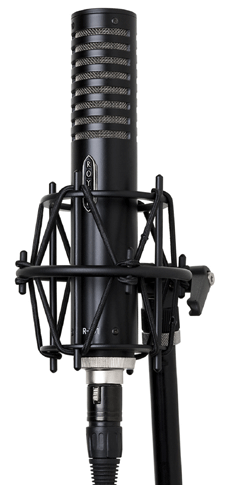|
|
Royer R-101 Ribbon Studio Mic
|
|
|
 Royer's latest ribbon mic the R-101 is large and in charge--actually it's bigger and a little heavier than their first mic, the R-121 ribbon. Also a side-address mic and with a figure of eight mic polar pattern, the R-101 uses a patented offset-ribbon transducer.
Royer's latest ribbon mic the R-101 is large and in charge--actually it's bigger and a little heavier than their first mic, the R-121 ribbon. Also a side-address mic and with a figure of eight mic polar pattern, the R-101 uses a patented offset-ribbon transducer.
The offset-ribbon is a feature: it makes the backside produce a brighter sound as compared to the front, logo side. The ribbon is 2.5-microns thick, made from 99% pure aluminum and is placed in a magnetic field produced by powerful Neodymium magnets focused so that they increase the mic's sensitivity yet minimize stray magnetic radiation. In general all ribbon mics are especially sensitive to wind, plosives and a "P" popping vocalist, so the R-101 has an internal multi-layered windscreen. For close in vocals, an external pop screen is also recommended.
The R-101's kit includes an easy-to-adjust shock mount basket, sexy dust sleeve and foam-line carrying case. The mic has an output impedance of 300-ohms, a frequency range of 30Hz to 15kHz, weighs in at 17-oz and is finished in matte black.
I used a heavier boom stand and put the R-101 to work on my trusty little solid-state ZT Club Amp along side a brand new Shure SM57. Just like when I use the R-121, I aimed the logo side of the R-101 at the center of the speaker dustcover of the amp's 12-inch speaker. I angled the SM57 towards the dustcover but from midway out on the cone's diameter.
The SM57 produced the expected sound--a cutting mid-range tone while the R-101 sounded more balanced, warm but not dull. The R-101 gets the sound of the amp as it sounds in the room and if I could only use one mic, I'd go with the Royer R-101 in an instant because there is much more sound to work with initially.
On my Schiller baby grand piano, I placed two R-101s right over the hammers, as I prefer a bright and percussive sound garnered from that mic position. I used the backside of the mic for a brighter sound. With typical condenser mics, this "over the hammers" position is usually bright enough not to require EQ. If you are looking for a natural and warm sound, the same is true for the Royers. Without high frequency hype, I could hear more of the soundboard, the sound of the piano's cabinet and the rich and complex tones of the instrument.
As room mics, I liked the pair of R-101s on either side of the drum room. Again the overall sound was balanced and not overly bright and cymbal-heavy as is sometimes the case with condensers in the same positions. By rotating both the mics (make sure to rotate both mics together as the front and back sides are polarity or phase reversed) and their height above the floor from waist-high to overhead, I was somewhat able to dial in the ambient "mix" of kick, snare and toms relative to the cymbal splash. Cool!
The Royer R-101 is a fine way to vastly expand your sonic recording palette with a single purchase but buy two of these babies and capture it all in stereo! The R-101 sells for $895 and remember that, like all Royer mics, the R-101 comes with a lifetime warranty logged to the original owner and the first re-ribbon is free. www.royerlabs.com. 818-847-0121.
|
|
|